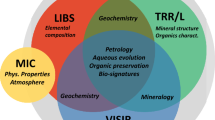Abstract
For understanding the universe from gravitational wave astronomy, multi-wavelength observation will be important, analogous to EM astronomy advanced over the preceding decades. Multi-wavelength observations will be enabled with a variety of detection methods, including ground-based or space-borne interferometers and pulsar timing arrays. In particular, space experiments will open up a new range of frequencies, 10–7–10–1 Hz, for the observation of gravitational waves. They will allow us to study various gravitational wave physics in the unexplored parameter space of strain and frequency and will benefit the field, producing complementary results to further our knowledge on gravitational waves. We review briefly the detection of low-frequency gravitational waves, citing detailed references.


Similar content being viewed by others
References
J. Weber, Phys. Rev. 117, 306 (1960)
P. Astone et al., Phys. Rev. D 82, 022003 (2010)
M.E. Gertsenshtein, V.I. Pustovoit, Sov. Phys. JETP 16, 433 (1962)
G.E. Moss, L.R. Miller, R.L. Forward, Appl. Opt. 10, 2495 (1971)
B.P. Abbott et al., Phys. Rev. Lett. 116, 061102 (2016)
B.P. Abbott et al., Astrophys. J. Lett. 848, L12 (2017)
B.P. Abbott et al., Phys. Rev. Lett. 119, 161101 (2017)
A. Abramovici et al., Science 256, 325–333 (1992)
A. Brillet, A. Giazotto et al., Virgo Project Technical Report No. VIR-0517A-15, 1989
T. Akutsu et al., KAGRA: 25 generation interferometric gravitational wave detector. Nat. Astron. 3, 35–40 (2019)
D. Reitzer et al., ar**v:1907.04833 (2019)
Stefan Hild, Simon Chelkowski and Andreas Freise, ar**v:0810.0604 (2008)
K. Danzmann, LISA Laser Interferometer Space Antenna–A proposal in response to the ESA call for L3 mission concepts. Albert Einstein Inst. Hanover, Leibniz Univ. Hanover, Max Planck Inst. Gravitational Phys., Hannover, Germany, Tech. Rep (2017)
K. H. Danzmann et al., LISA Proposal for a Laser Interferometric Gravitational Wave Detector in Space, report of Max-Planck-Institut fuer Quantenoptik (1993).
S. Kawamura et al., Class. Quant. Gravity 28, 094011 (2011)
J. Crowder, N.J. Cornish, Phys. Rev. D 72, 083005 (2005)
M. Armado et al., Phys. Rev. Lett. 116, 231101 (2016)
M. Armado et al., Phys. Rev. Lett. 120, 061101 (2018)
R.M. Shannon et al., Science 342, 334–337 (2013)
S. Detweiler, Astrophys. J. 234, 1100–1104 (1979)
J.P.W. Verbiest, MNRAS 458(2), 1267–1288 (2016)
B.B.P. Perera, MNRAS 490(4), 4666–4687 (2019)
R.S. Foster, D.C. Backer, Astrophys. J. 261, 300–308 (1990)
D.J. Reardon et al., MNRAS 455(2), 1751–1769 (2016)
Z. Arzoumanian et al., Am. Astron. Soc. 235(2), 37 (2018)
G. Desvignes et al., MNRAS 458(3), 3341–3380 (2016)
P.A.R. Ade et al., The keck array and BICEP2 collaborations. Phys. Rev. Lett. 121, 221301 (2018)
P.A.R. Ade et al., Astrophy. J. 794, 171 (2014). (The POLARBEAR collaboration)
E. Calabrese et al., Phys. Rev. D 95, 063525 (2017)
W.L.K. Wu et al., Astrophys. J. 884, 70 (2019)
P.A.R. Ade et al., AAP 586, A141 (2016). (Planck Collaboration)
J.W. Armstrong, Living Rev. Relativ. 9, 1 (2006)
S. Kolkowitz, I. Pikovski, N. Langellier, M.D. Lukin, R.L. Walsworth, J. Ye, Phys. Rev. D 94, 124043 (2016)
S. Dimopoulos et al., Phys. Lett. B 678, 37 (2009)
J. Magorrian et al., Astron. J. 115, 2285 (1998)
D. Merritt, L. Ferrarese, ApJ 547, 140 (2001)
S. Tremaine et al., ApJ 574, 740 (2002)
L. Ferrarese, R.W. Pogge, B.M. Peterson, D. Merritt, A. Wandel, C.L. Joseph, ApJ 555, L79 (2001)
A. Laor, ApJ 553, 677 (2001)
E. Ba-nados et al., Nature 553, 473–476 (2018)
J. S. B. Wyithe, A. Loeb, astro-ph/0206154 (2002)
G. A. Shields, K. Gebhardt, S. Salviander, B. Wills, B. **e, M. Brotherton, J. Yuan, M. Dietrich, astro-ph/0210050 (2002).
P. Amaro-Seoane, M. Preto, Class. Quant Gravity 28, 094017 (2011)
D. Aharon, B.P. Hagai, Astrophys. J. Lett. 830, L1 (2016)
L.P. Grishchuk, JETP 40, 409–415 (1974)
L.P. Grishchuk, JETP Lett. 23, 293 (1976)
C. L¨ammerzahl, C. W. F. Everitt and F. W. Hehl, Lecture Notes in physics, vol. 562, 167, (Springer Science & Business Media, 2001).
L. P. Grishchuk, Topical and Timely Reviews on Astrophysics (Ed. Mason, J.) p281. (Berlin: Springer, 2004).
B.P. Abbott et al., Phys. Rev. D 100, 061101 (2019)
B.P. Abbott et al., Phys. Rev. Lett. 120, 091101 (2018)
M.G. Haehnelt, MNRAS 269, 199 (1994)
S. A. Hughes, S. Marka, P. L. Bender and C. J. Hogan, astro-ph/0110349 (2001).
V.M. Kaspi, J.H. Taylor, M.F. Ryba, ApJ 428, 713 (1994)
S.E. Thorsett, R.J. Dewey, Phys. Rev. D 53, 3468 (1996)
A. N. Lommen, astro-ph/0208572 (2002).
K. H. Danzmann et al., report of Max-Planck-Institut fuer Quantenoptik (1993).
T. A. Prince et al., list.caltech.edu/mission_documents (2009)
O. Jennrich, Class. Quant. Grav. 26, 153001 (2009)
SAO/NASA Astrophysics Data System 2012 papers mentioning LISA in the abstract tinyurl.com/lisa-ads.
Pau Amaro-Seoane et al., ar**v:1202.0839 (2012).
I.H. Park et al., ar**v:1906.0618v2 (2019).
C.J. Moore, R.H. Cole and C.P.L. Berry, Class. Quant. Gravity 32, 015014 (2015)
Acknowledgment
We acknowledge the support from the National Research Foundation (NRF) of Korea: NRF-2021R1A2B5B03002645 and NRF-2017K1A4A3015188.
Author information
Authors and Affiliations
Corresponding author
Additional information
Publisher's Note
Springer Nature remains neutral with regard to jurisdictional claims in published maps and institutional affiliations.
Rights and permissions
About this article
Cite this article
Park, I.H. Detection of low-frequency gravitational waves. J. Korean Phys. Soc. 78, 886–891 (2021). https://doi.org/10.1007/s40042-021-00118-x
Received:
Accepted:
Published:
Issue Date:
DOI: https://doi.org/10.1007/s40042-021-00118-x




